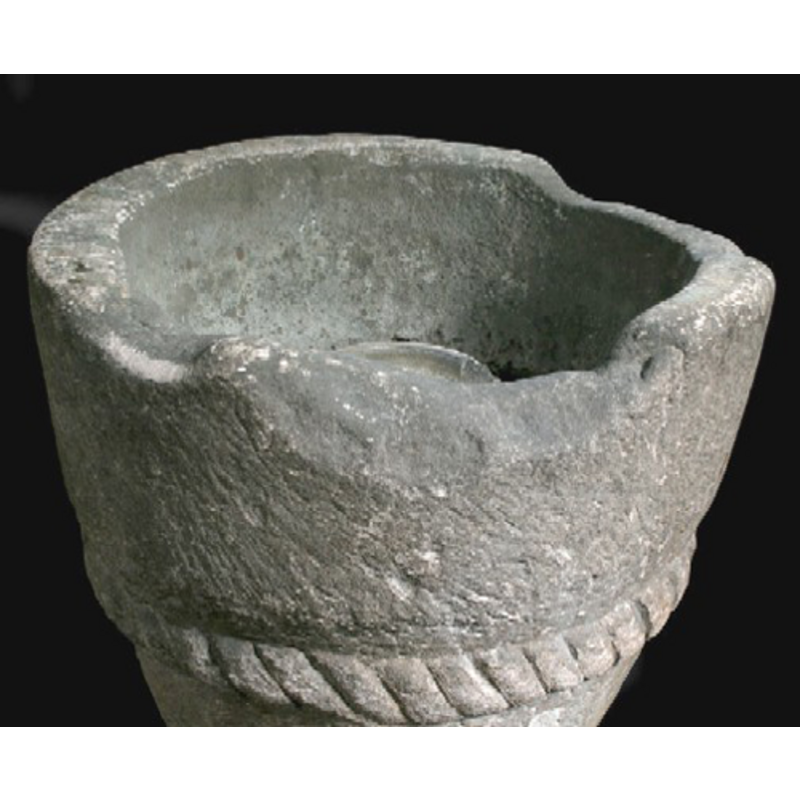Selston

Image copyright © Geoff Buxton, 2006
Permission received
Results: 4 records
BBL01: design element - motifs - rope moulding
view of basin
view of font and cover
INFORMATION
FontID: 15492SEL
Object Type: Baptismal Font1
Church/Chapel: Parish Church of St. Helen
Church Patron Saints: St. Helena
Country Name: England
Location: Nottinghamshire, East Midlands
Directions to Site: Located W of Annesley, N of Underwood, near the county border with Derbyshire
Font Location in Church: Inside the church
Century and Period: 12th century (mid?) [basin only] [re-cut?] [composite font], Medieval [composite]
Font Notes:
Click to view
Described and illustrated, with notes on its eventful past, in Buxton (1912): "At the west end of the south aisle stands the old bucket-shaped Norman font, decorated with a single band of cable moulding. It will be seen that it is badly worn, a condition explained by its varied history. Over a hundred and fifty years ago it was removed from the church and carried to Blackwell. After a time it was brought back to Selston, where it did duty as a trough under the pump at the village inn, the 'Bull and Butcher.' Then it was used as a vase in a private garden. Eventually, through the energy of the vicar (Rev. C. Harrison), it was recovered and once more placed in the church. The worn appearance of the top is due to its having been used as a knife-sharpener." In Cox (1912) with much the same information. Listed in Guilford (1927) as a Norman font. The font is shown in Buxton's illustration as an octagonal basin with plain vertical sides and a plain chamfer, with a thick rope moulding between upper basin sides and chamfer, all around; raised on a plain octagonal stem. The wooden cover shown in Buxton [cf. supra] is a flat plain one. Doubleday, in The Nottingham Guardian [http://www.nottshistory.org.uk/articles/doubleday/selston2.htm] [accessed 17 October 2009] (1956) referred to an early-19th century visit to the church: "Stretton, who was here with his notebook in 1813, described the church as in a sore state of decay. The pulpit lay in the chancel, the font lay broken in the churchyard, and the chancel, he said, was "far in decay." Subsequently, the walling developed cracks, and in 1899, the fabric was completely restored." But Doubleday is glad to report that, by the time of his writing [1956], "the Norman font has been rescued from service as the horse-trough of an inn". This information was also gathered in 'The Story of Selston Parish Church', by the Revd. Edward Dunicliff [http://www.jacksdale.org.uk/pages/JDHeritage/ChurchH-Harrison.htm] [accessed 17 October 2009]: "The Church had a chequered history from commonwealth days onwards until the end of the nineteenth century. It was neglected, and fell slowly into ruin, but the energies of the Rev. Charles Harrison saw its restoration in 1905-1906. Mr Harrison was instrumental in securing the return of the Norman Font, which had been ejected by the Puritans, and which had served as a drinking trough as well as a sharpening block for butchers’ knives; it had been away for over two hundred and fifty years" [NB: Harrison had been vicar of Selston from 1887 until his death in 1916]. The old Norman basin is actually round -not octagonal- above the rope moulding, with much damage showing, especially around the upper rim, more than half of which is now missing; it is also quite possible that the octagonal chamfer may have been re-cut into that shape when the old basin was fitted with the new octagonal base in the 19th century; the octagonal stem and lower base of the shape, as well as the rectangular plinth on which the font stands are modern. The wooden cover appears to be the same one depicted in Buxton. Not mentioned in Pevsner & Williamson (1979).
MEDIUM AND MEASUREMENTS
Material: stone
Font Shape: round (mounted)
Basin Interior Shape: round
Basin Exterior Shape: round
LID INFORMATION
Material: wood
Apparatus: no
Notes: [cf. FontNotes]
REFERENCES
Buxton, A.S., "Selston church", 16 (1912), Transactions of the Thoroton Society, 1912
Cox, John Charles, Nottinghamshire, London: Allen, 1912
Guilford, Everard Leaver, Nottinghamshire, London: Methuen, 1927

